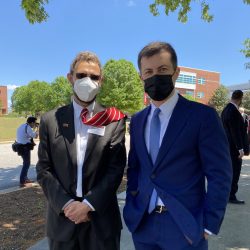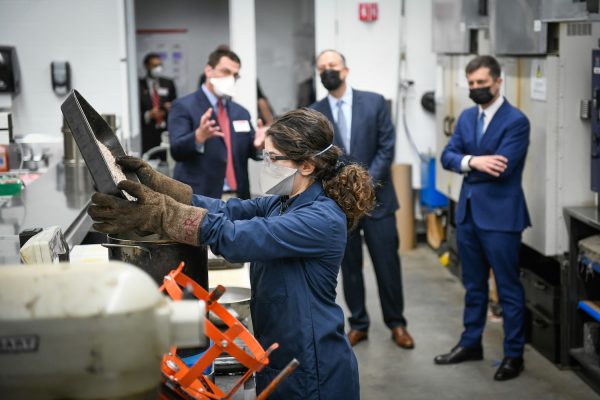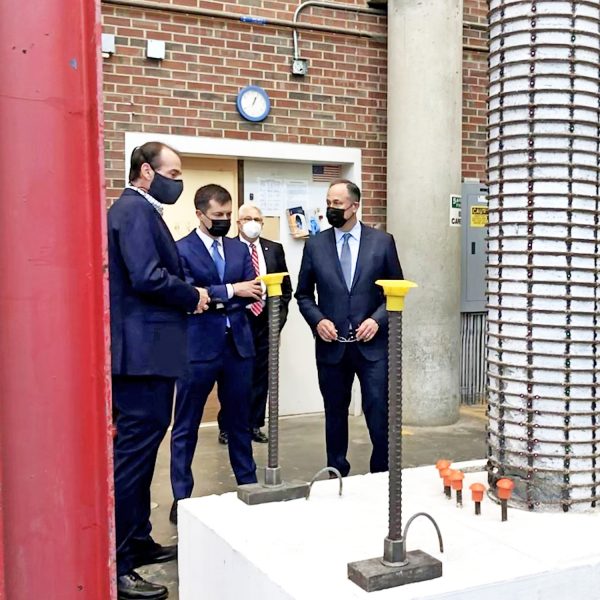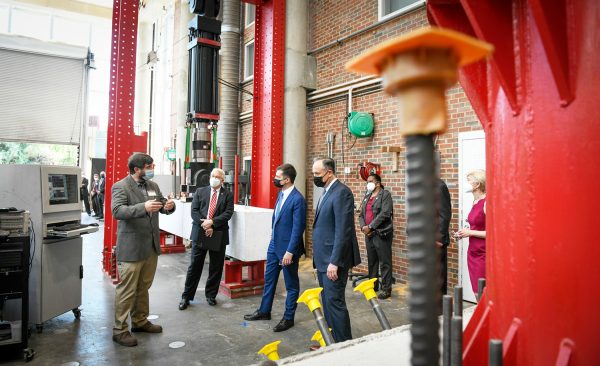On Friday, April 30, Second Gentleman Doug Emhoff, Transportation Secretary Pete Butiggieg, and congressional representatives Debra Ross and David Price visited NC State’s Centennial campus. It was an exciting visit with faculty and students, which included parts of the brand new Fitts-Woolard Hall like our transportation materials lab. The group then walked across campus to our Constructed Facilities Lab.

“The visit was a fantastic opportunity to give high level government officials an opportunity to see research in action and how our research is leading to restoring America’s infrastructure in a sustainable and cost-effective manner. It was a great day for CCEE, ISE and NC State as a whole.” Dr. Morton Barlaz, CCEE Department Head

As faculty prepared for the high profile visitors, they knew that they would have limited time to explain and demonstrate research, so examples were chosen carefully.
Asphalt pavement represents the largest infrastructure investment in the US, and NC State has a large research program in asphalt pavement. Drs. Cassie Castorena and Shane Underwood and a team of their graduate students demonstrated the preparation of an asphalt sample in the mixing lab. “We then demonstrated how we use state-of-the-art instrumentation to test asphalt,” Castorena continued. The team showed Buttigieg and the other guests how an instrument called a Hamburg wheel tracking device allows the researchers to measure both cracking and rutting.
 The next stop was the Constructed Facilities Lab, where researchers work closely with industry, numerous departments of transportation, the US Army Corps of Engineers, and the National Science Foundation. “Large scale testing of various components of infrastructure including long beams, bridge columns, and concrete are conducted to support unique, sustainable and resilient infrastructure construction and repair,” explained Dr. Greg Lucier, who presented two demonstrations along with Dr. Mervyn Kowalsky and their teams.
The next stop was the Constructed Facilities Lab, where researchers work closely with industry, numerous departments of transportation, the US Army Corps of Engineers, and the National Science Foundation. “Large scale testing of various components of infrastructure including long beams, bridge columns, and concrete are conducted to support unique, sustainable and resilient infrastructure construction and repair,” explained Dr. Greg Lucier, who presented two demonstrations along with Dr. Mervyn Kowalsky and their teams.
“We showed them a concrete bridge column that had buckled and fractured in a simulated earthquake. Then we demonstrated how a column that ordinarily would be considered a total loss can actually be repaired and put back into use.” Dr. Mervyn Kowalsky

The visitors then observed a test to failure of an experimental ultra-high performance concrete (UHPC) floor system. UHPC is an advanced material similar to traditional concrete, but with much greater strength and durability. Bridges built with UHPC can have a design life more than double that of traditional bridges. “The project supporting this work is a collaboration of multiple universities, precast concrete fabricators, and engineering firms,” Kowalsky told the visitors. The work is sponsored by the Precast Concrete Institute and is followed by at least 7 state DOTs and the Federal Highway Administration.

